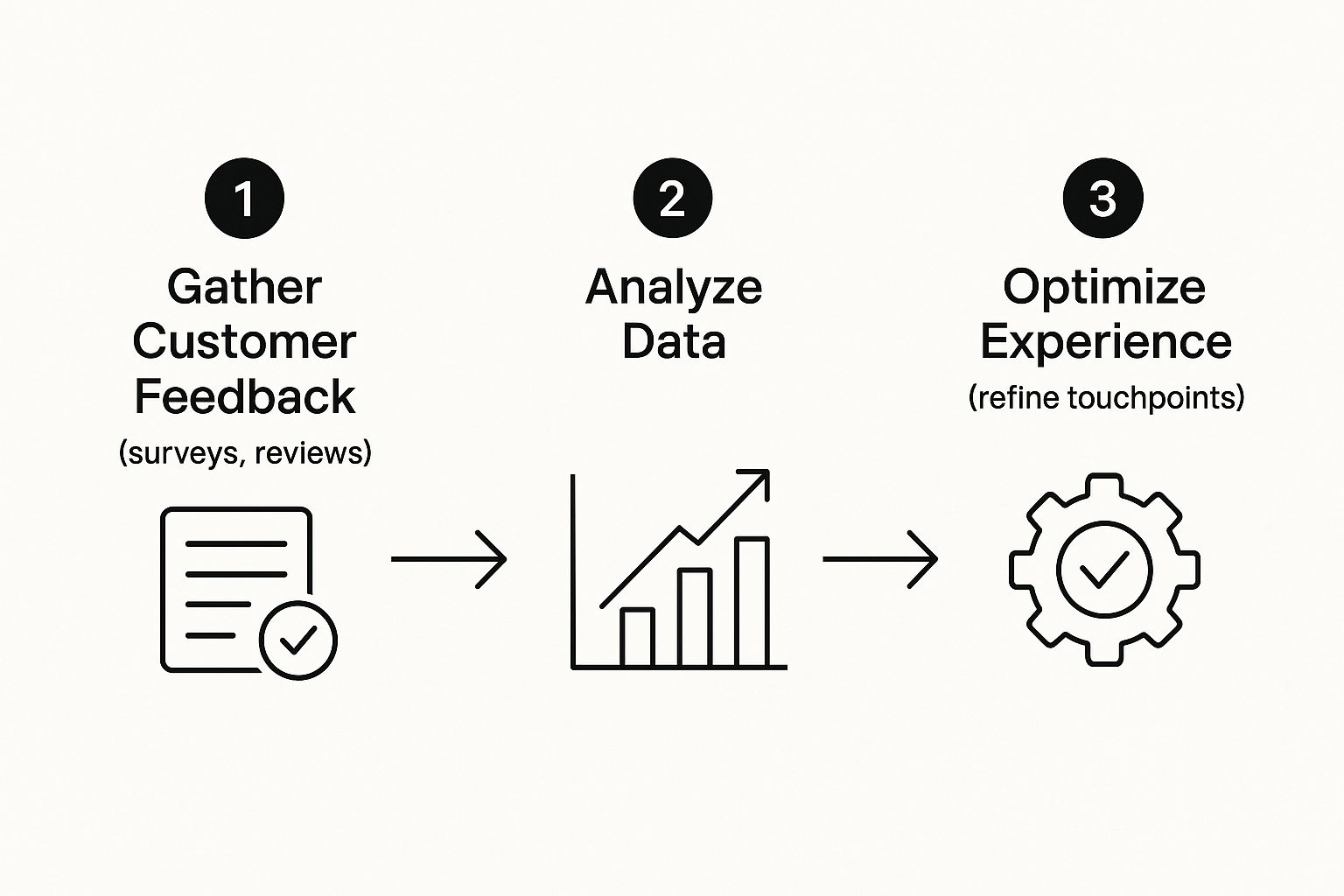Let's cut through the jargon. At its core, customer experience management (CEM) is the art and science of intentionally designing and reacting to every single interaction a customer has with your business. It’s a proactive strategy focused on the entire customer journey, not just a single problem or transaction.

Think about the concierge at a five-star hotel. Their job isn’t just to check you in and hand you a key. It’s to make sure your entire stay is seamless and memorable, from the moment you book the room until you wave goodbye from the taxi.
CEM applies that exact same philosophy to any business. It covers every touchpoint a customer could possibly have with your brand, big or small.
This includes everything from them seeing your ad on social media, to poking around on your website, to chatting with a support agent, and even the follow-up email they get a week later. The goal is to carefully shape their overall perception of your company by making each of those interactions positive, consistent, and completely effortless.
It's really easy to get CEM mixed up with customer service or even customer relationship management (CRM), but they all play very different roles on the same team. Customer service is mostly reactive—it's about jumping in to solve a specific problem when it pops up. A CRM, on the other hand, is the toolbox you use to manage all your customer data and track interactions.
CEM, however, is the overarching business strategy. It pulls data from your CRM and learns from customer service conversations to proactively design a better journey from the start. It’s all about preventing problems before they ever happen and creating an experience that feels great, time and time again.
This strategic shift is a big deal, and the market reflects it. The CEM market was valued at USD 19.34 billion and is projected to skyrocket to USD 68.24 billion by 2032. That’s a clear sign that businesses are taking this holistic approach very seriously.
A huge part of a strong CEM strategy is building an omnichannel experience, where every communication channel works together in harmony. To see how this fits into the bigger picture, you can check out our guide on what is omnichannel customer service.
To make the distinction crystal clear, let's break down how these three concepts compare.
This table should help you quickly see where each concept fits.
As you can see, while customer service and CRMs are essential pieces of the puzzle, CEM is the strategy that puts them all together to create a winning customer journey.

A truly successful Customer Experience Management (CEM) strategy doesn't just happen. It’s not about guesswork or one brilliant idea. Instead, it’s built on three foundational pillars that work together, creating a solid, customer-focused structure for the whole company.
Think of them as the legs of a stool—if one is missing, the whole thing topples over.
By understanding these core components, you can shift from simply reacting to problems to proactively anticipating needs and shaping positive, memorable interactions from the get-go.
The first and most important pillar is getting a genuine, profound understanding of who your customers are. What do they need? How do they really feel about your brand? This goes way beyond surface-level demographics.
Truly understanding your customer means you have to become an expert listener across every channel. This involves:
This pillar is all about gathering intelligence. You can’t build a better experience until you know exactly what your customers are going through right now and what they truly want from you.
Data is useless if it just sits on a dashboard gathering digital dust. The second pillar is all about turning that intelligence into meaningful action. This is where you close the feedback loop and show customers you’re not just listening, but you’re actually doing something about it.
Acting on insights means giving your team the power to make real-time decisions that improve a customer’s situation on the spot. For instance, instead of just escalating a complaint up the chain, an employee might be authorized to offer an immediate discount or a creative solution.
An effective CEM strategy transforms feedback from a historical record into a real-time tool for improvement. The goal is to solve not only the individual customer's issue but also to identify and fix the root cause to prevent it from happening again.
To see this in practice, exploring the dos and don'ts of enhancing customer experience offers a great roadmap for turning those insights into concrete actions.
Finally, the third pillar ensures that delivering a fantastic customer experience is everyone’s job, not just a task for the "customer service department." A truly customer-centric culture weaves this priority right into the company’s DNA.
This means every single employee, from the CEO down to the front-desk receptionist, understands their role in shaping the customer's journey. It requires clear communication, consistent training, and giving your team the tools and authority to make decisions that put the customer first.
When your entire organization is aligned around this shared mission, you create a consistently positive experience at every turn.

It’s one thing to talk about making customers happy, but how does that actually show up on the balance sheet? A solid Customer Experience Management (CEM) strategy isn’t just a feel-good initiative or a cost center. It’s a powerful profit center.
When you invest in CEM, you’re directly impacting things like customer lifetime value (CLV), churn rates, and your Net Promoter Score (NPS). Think about it: a customer who has a great, frictionless experience is way more likely to buy from you again, spend more over time, and—best of all—tell their friends about you.
This isn't a secret. The global CEM market is exploding for this very reason. Valued at roughly USD 22.44 billion, it's on track to more than double to USD 51.11 billion by 2030. That kind of growth sends a clear message: businesses know that incredible customer interactions are what fuel real loyalty and revenue. You can dig into the numbers yourself in this in-depth market analysis on mordorintelligence.com.
Let’s bring this down to earth with an example. Imagine an online store that uses customer data to personalize what you see. Instead of a generic homepage, it shows you products based on what you’ve bought or browsed before.
That simple touch often leads to a higher average order value. When a customer feels like you "get" them, they're more confident in their purchase and more open to suggestions. A small sale can quickly become a much larger one.
A superior customer experience transforms one-time buyers into repeat customers and, eventually, into loyal brand advocates. This shift is where sustainable growth happens, turning your customer base into your most valuable asset.
Or consider a software company. If their onboarding process is clunky and confusing, customers will bail—fast. By making the setup process smooth and intuitive, the company hangs onto more subscribers, which directly boosts their monthly recurring revenue.
Great CEM creates a positive feedback loop that makes your whole business stronger. When you consistently focus on making every interaction easy and valuable, you’ll see the needle move on several critical metrics.
Ultimately, building that kind of deep, unshakable loyalty is the goal. For a closer look at how to achieve this, check out our guide on mastering the art of creating customer loyalty. Each of these benefits proves that putting money into your customer's experience is one of the smartest financial moves you can make.
Knowing what customer experience management is sets the stage, but building a practical framework is where the real work begins. Creating a structured CEM program isn't about one big, grand gesture. It's a systematic process of listening, analyzing, and acting in a continuous cycle.
Think of it like building a bridge. You can't just start laying planks from one side and hope you land in the right spot. You need a solid blueprint—one that starts with a clear vision of the destination, identifies every support pillar needed along the way, and includes a method for testing its strength. A CEM framework is that blueprint for your customer journey.
Let’s walk through the essential steps to construct your own. We'll use a hypothetical B2B software company as our guide. Their big problem? A clunky and confusing client onboarding process, a critical "moment of truth" that was causing new customers to bail early.
Before you can map a single journey or send out a survey, you have to define what a perfect customer experience actually looks like for your business. This vision becomes your North Star, guiding every decision you make from here on out.
For our B2B software company, the vision was simple: "Make new clients feel confident and empowered within their first 30 days." This isn't just a vague goal; it's a specific, measurable outcome. It shifts the focus from simply "getting them set up" to ensuring they achieve an early, meaningful win with the product.
With that clear vision in place, the next step is to pinpoint the most critical customer journeys that affect it. You can't fix everything at once, so don't try. Start with the path that has the biggest impact on customer perception and your bottom line.
Our software company zeroed in on the onboarding journey, mapping every single touchpoint a new client goes through:
Mapping these steps brought several friction points to light, like a 48-hour wait for the welcome email and confusing jargon in the initial setup guide.
Once you know the key touchpoints, you need to measure the experience at each one. This is where feedback tools like Net Promoter Score (NPS) and Customer Satisfaction (CSAT) surveys come into play.
Our B2B company implemented a short CSAT survey immediately after the first training call. They also sent a broader NPS survey 30 days post-onboarding. The data quickly showed that while clients loved their human onboarding specialist (high CSAT), they were deeply frustrated with the initial self-serve setup (low NPS). This pinpointed the exact root cause of their churn problem.
This simple infographic breaks down the core feedback loop process for any CEM framework.

As you can see, it's a clear, repeatable cycle where gathering feedback directly fuels the analysis that leads to targeted improvements.
Building a successful customer experience management framework is less about a one-time project and more about creating a perpetual engine for improvement. The goal is to make listening, analyzing, and acting a core part of your company's operational rhythm.
The final step is to empower your teams to actually act on these insights and continuously iterate. Data without action is just noise.
Our software company created a cross-functional "onboarding squad" with folks from product, support, and marketing. Armed with the feedback data, they redesigned the welcome email to go out instantly, simplified the setup guide, and created short tutorial videos. They turned those insights into tangible improvements that made a real difference.
You can't do modern customer experience management on vibes alone. You need a powerful toolkit. To create those seamless, personalized journeys that customers now demand, businesses lean on an integrated stack of technologies working together behind the scenes.
Think of it less like a single magic tool and more like an orchestra. Each piece of software is an instrument, and they all have to play in harmony to create the final symphony your customer hears.
The foundation, the conductor of this orchestra, is usually the Customer Relationship Management (CRM) system. This is the central brain. It collects and organizes every single piece of customer data—from their purchase history to their latest support ticket—into one unified view. Without it, customer information gets trapped in different departments, and trying to create a coherent experience is pretty much impossible.
From there, you start layering on more specialized tools to handle specific jobs.
Analytics platforms are the detectives of the operation. They dig into all the data your CRM collects to uncover trends, pinpoint where customers are getting stuck, and actually measure if your efforts are making a difference.
Next up, you have your feedback management tools. These are your direct lines to your customers, capturing their true voice through things like:
The real magic happens when you connect these systems. When your feedback tool can automatically create a support ticket in your CRM because of a negative review, you create a lightning-fast response loop. You solve problems before they have a chance to blow up.
The biggest shift in customer experience technology right now is the rise of artificial intelligence (AI) and machine learning (ML). This isn't some far-off sci-fi concept anymore; these are practical tools that automate and seriously elevate the customer experience, and they do it at scale.
AI-powered predictive analytics can sift through mountains of customer data to anticipate what someone needs, suggesting the right product or help article before they even realize they're looking for it.
The global Customer Experience Management market has seen major growth fueled by technologies like AI, machine learning, and the Internet of Things (IoT). This tech-driven transformation allows for real-time engagement and highly personalized service delivery. For example, automakers now use AI-powered sensors in vehicles to offer predictive maintenance alerts, directly improving customer satisfaction. Find out more about this market growth on grandviewresearch.com.
AI-powered solutions like an automated front desk or a well-trained chatbot can provide instant, 24/7 support. They handle the common questions immediately, which frees up your human agents to tackle the really tricky problems. This blend of automated efficiency and human expertise is what modern CEM is all about—turning vast amounts of data into genuinely better experiences for every single customer.
Rolling out a successful customer experience management program is an incredibly rewarding journey, but it’s rarely a straight line. Even the most carefully crafted strategies can hit a wall if you don’t plan for the usual speed bumps. Knowing how to navigate these challenges is what separates a stalled initiative from one that truly changes your business.
The first major hurdle is often getting genuine buy-in from the top. It's one thing for leaders to agree with the idea of better customer experience, but it's another for them to free up the budget and resources without a clear link to the bottom line. The secret? You have to speak their language: prove the ROI.
Forget trying to boil the ocean with a massive, company-wide overhaul from day one. Instead, pick a high-impact, low-friction area of the business and launch a focused pilot project. Track obvious before-and-after metrics—things like customer churn, average order value, or the number of support tickets. When you can show tangible data, the business case for a bigger CEM investment becomes impossible to ignore.
Another classic roadblock is the dreaded departmental silo. When marketing, sales, and support all operate in their own little worlds, the customer's journey becomes a choppy, frustrating mess. A customer doesn't see your departments; they just see one company. A bad handoff at any point can poison their entire perception of your brand.
The best way to fight this is to create cross-functional "journey teams." Dedicate a team to a specific stage of the customer lifecycle, like onboarding or post-purchase support. Pull people from every relevant department into that team, making sure they’re all chasing a single goal: making that part of the experience totally seamless.
A siloed organization forces the customer to do the hard work of connecting the dots between departments. A truly customer-centric company does that work for them, creating a single, coherent conversation.
This collaborative approach guarantees that the insights one team uncovers are shared and acted on by everyone. It also helps you pinpoint and fix problems at the source instead of just slapping a bandage on them downstream. A huge part of this is handling issues when they pop up, and our guide on bouncing back from customer complaints with service recovery strategies offers practical steps for turning a negative moment into a loyal customer.
By getting ahead of these roadblocks, you can build a customer experience management framework that’s resilient, effective, and delivers results that stick.
Getting started with customer experience management can feel a bit overwhelming, so it’s natural to have a few questions. Let's clear up some of the most common ones we hear from business owners just like you.
Before you do anything else, you need to get your leadership team on board. The best way to do that is by painting a clear picture of what the ideal customer experience should look like for your business.
Start small. Map out one or two key customer journeys and pinpoint the biggest frustrations they face. A focused pilot project is much easier to manage and gives you the quick wins you need to prove the value of CEM and build momentum.
You'll want to use a few different metrics to get the full picture. The heavy hitters are Net Promoter Score (NPS), which tells you a lot about customer loyalty, and Customer Satisfaction (CSAT), which is great for feedback on specific interactions. Don't forget Customer Effort Score (CES)—it measures how easy you are to do business with.
The real magic happens when you connect these scores to bottom-line results, like better customer retention rates and a higher lifetime value (CLV).
Don't fall into the trap of thinking CEM is just for big B2C companies. These principles are just as vital for B2B and small businesses. In B2B, the experience during a long sales cycle can make or break a deal. For small businesses, an amazing customer experience is one of the most powerful ways to stand out against larger, more impersonal competitors.
Ready to enhance your customer experience with an AI-powered receptionist that never misses a call? My AI Front Desk helps small businesses convert more leads and streamline communication 24/7. Discover how our AI solutions can transform your front desk operations today!
Start your free trial for My AI Front Desk today, it takes minutes to setup!








